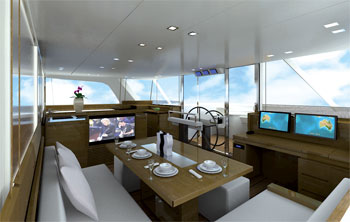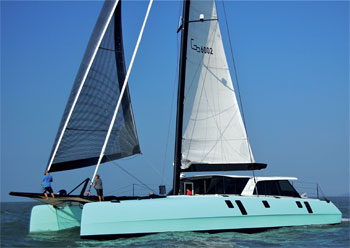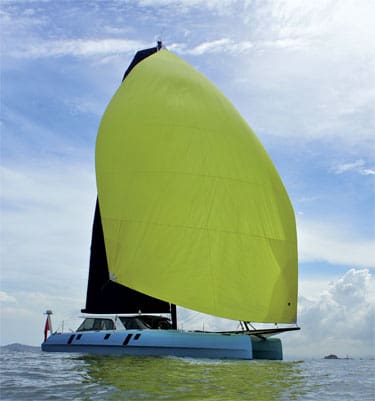Anyone who thinks that 300-nm days are reserved for racing yachts will be pleasantly surprised to learn that the Gunboat 60 catamaran considers it routine. Not fast enough? How about adding 100 nm — conditions permitting, of course — and this extraordinary performance doesn’t require the owners and crew to give up any of the luxury modern cruising sailors expect. (On July 15, 2013, the Gunboat 66 Phaedo clocked 427 nm in 24 hours.)
Peter Johnstone, CEO and founder of Gunboat, conceived the company’s line of comfortable high-performance cruising catamarans backward from the extremes of racing cats. Tribe, hull No. 1 of the very successful Gunboat 62 designed by Morrelli & Melvin Design & Engineering in 2001, is the mother of the Gunboat 60. Although the basic criteria of minimal weight, high speed and luxury remain consistent, the 60 and her siblings (55 and 78) come from the drawing board of Nigel Irens, who earned his fame designing record-breaking offshore racing cats and trimarans.
 |
|
Courtesy Gunboat |
|
The heart of all Gunboats is the great room. This main saloon features 360 degree views. Gunboat’s layout provides for a spacious galley. |
The Gunboat 60 unequivocally proves that luxurious cruising cats needn’t be ugly. Irens has given her a graceful reverse sheer line, an upright but stylish deckhouse, and reverse stems. These bows may seem like an affectation on a cruising yacht, but their fine sections pierce the waves and allow the hulls to shed water if they bury. In order to provide generous headroom in the hulls and maintain adequate clearance between the water and the bridge deck, the Gunboat 60 has a lot of freeboard. The early yachts were a bit wall-sided, but Irens avoided that perception via a substantial longitudinal break along the topsides and a sprinkling of portlights in the after third of each hull. This break helps to keep the water from climbing the hulls, and its curvature complements the sheer line. He also drew a significant tumblehome — most obvious when we look at the yacht from the bow or stern — in the hulls. This increases the width and interior volume of each hull at about shoulder height and goes a long way toward reducing the slab-side visual height of the earlier yachts.
An abundance of volume likely attracts more buyers to cruising cats than any other characteristic. Sailing on the level follows closely on many shoppers’ wish lists. Just about any catamaran would fulfill those wishes, but only two brands that I know of give the owner a cockpit forward of the deckhouse saloon and immediately abaft the mast. The Gunboat 60 is one of those, and you have to experience it to believe it. Sightlines from the cockpit of conventional cats are compromised by the yacht’s basic configuration. In order to provide a helm that lets you see the bows, the boat needs a flying bridge or a raised helm station in each hull. These unsightly excrescences raise the center of gravity, create windage, and detract from the ambience of the afterdeck.
The most amazing part of driving a fast cat from forward of the deckhouse is the sense of speed you get. When I sailed with Johnstone aboard hull No. 1 of the original 62, I felt closer to the elements, more in tune with the sea, but still protected. In most conditions, that driver’s cockpit stays dry, too. From this helm, you can see the tell-tales on the headsails and the main. When the weather turns ugly, you may step into the deckhouse and drive from inside, aided by an assortment of buttons to hydraulically mind the sails.
Gunboat has divided the common area roughly in half. The wide and bright saloon spans all but about 12 feet of the yacht’s overall beam. In there, you find a spacious dinette on the starboard side and the seamanlike U-shape galley opposite. Stowage cabinets below the wood-veneer counters hold the usual galley tools. Pots and pans stow under the stove/oven. A double stainless steel sink takes some of the drudgery out of cleanup. Vitrifrigo two-drawer refrigerator and separate freezer live under the counters.
 |
|
Courtesy Gunboat |
|
Gunboats are engineered to round-the-world racing standards. Weight has been engineered out of the boat’s structures, while maintaining impressive safety margins. |
The equally spacious afterdeck has enough seating for a serious party and is partially sheltered from the sun by the coach roof’s overhang. Teak-paved stairs at the after end of each hull provide crews and guests with easy access to the water and the tender.
Every yacht demands compromise, and in designing a catamaran juggling the requirements of speed — narrow beam in each hull, rounded sections amidships and very fine entries — and the need for human-size spaces can be a nightmare. On the best cats, fine waterlines grow in width as you trace the sections toward the sheer line. Increasing the freeboard lets designers place a queen-size berth athwartships in each hull, as Irens has done aboard the 60. The master stateroom and head — with separate standup shower stall — are amidships in the starboard side hull. Steps on each side of the raised berth give the occupants easy access to a quiet night.
In the portside hull, there’s another queen berth, which is a mirror image of the one in the master. This guest cabin shares a head with the guest quarters in the after end of this hull. A small over/under cabin for crew or surprise guests lives forward of the amidships cabin. It also maybe used as a workroom. A deck hatch provides access to this area when the stateroom is occupied, but when it’s empty, crew may pass through the stateroom. Counters in all the heads are Corian.
Following modern trends in rigs, the Gunboat carries a flat-top fully battened mainsail set on carbon-fiber spars. The sail flakes into a wide V-boom and sleeps under its integral cover. Foldaway aluminum steps give access to the lowered mainsail. Headsails reef and stow on roller furlers. The sail plan is large but easily managed via hydraulic winches.
Cruising aboard a fast and seakindly catamaran may be one of the all-time great experiences. Their spaciousness and general arrangement plans allow more privacy than any monohull of comparable length, and their speed gives the owners the option of avoiding bad weather.
Gunboat will display a 60 at the United States Sailboat Show this October. You owe yourself a look.
———–
Dennis Caprio is senior contributing editor at Yachting Magazine and freelance writer living in Newport, R.I. His work also has appeared in a wide variety of marine magazines.

